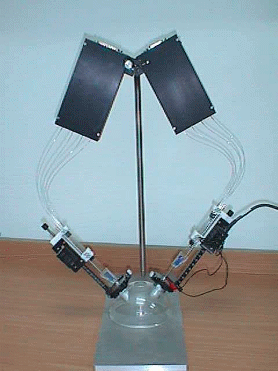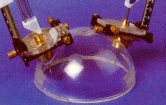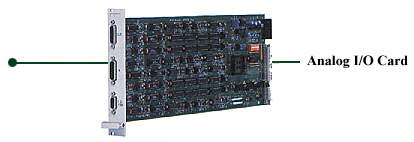

IBIS Instrumentation Canada is pleased to announce its exclusive distributorship in Canada for Alpha Omega Engineering, the Israeli developers and manufacturers of a complete family of modular setups for extracellular recording.
Use of this state-of-the-art equipment has many advantages. Consider the following:
These pages feature the main components of an Alpha Omega setup:
- Electrode Positioning System (EPS)
- Microdrive terminal (MT)
- Head Stage Pre-Amplifier
- Multi Channel Processor (MCP)
- Multi Spike Detector (MSD)
- 4-channel Isolated Preamplifier (Alpha-IsP)
- Alpha-Map Data Acquisition System
For more information on Alpha Omega equipment, please contact us.
| manipulates a large number of extracellular microelectrodes simulaneously and independently to record activity from the nervous system. |
| Modular, Flexible and Compact Begin with a small number of electrodes and upgrade easily to more than 16 channels. Testing from different areas and angles of the brain simultaneously is a huge benefit due to its modularity, flexability, and compactness. Since each electrode can be manipulated individually, you have the optimum ability to ensure the best recording results. High Resolution, Long Working Distance The EPS has a long working distance of 40mm and a resolution of 1 µm. This enables you to reach any brain location, even in large animals, and place the electrode exactly in the desired position to achieve optimum recording conditions MT: Microdrive Terminal for holding and initial positioning of the microelectrodes This device, placed on the animal skull, holds the microelectrodes, and connects them via the flexible shafts to the EPS (see figures at right). One MT can handle up to 8 electrodes. The base consists of a XY manipulator table (see detail photo at right), which allows 16 mm movement in each direction. The initial depth of the electrodes can be set by a Z-axis adjustment knob (40 mm movement). A further 40 mm of depth control with a resolution of 1 µm can then be obtained by use of the EPS. |
 Overview of a full setup. Two Micromanipulators, connected via flexible shafts to two Microdrive Terminals, mounted on a perspex dome (representing the animal's skull).  Detail of the bases of the Microdrive Terminals. |
EPS Windows Software
User-friendly software (running under Windows 3.11 or Windows 95) gives greater control and flexibility...just click the mouse to apply a command on one or several electrodes. This applies to grouping, positionings, and moving of the electrodes.
| Standard Electrodes This practical feature cuts costs by using off-the-shelf (or custom-made) standard microelectrodes that perform without expensive servicing and are easy to obtain. |
HEAD STAGE PRE-AMPLIFIER The Head Stage Preamp
Head Stage Technical Specification:
Gain (fixed)
Power Supply
Casing
The Head Stage Pre-Amplifier is a single-channel,
miniature instrumentation (differential) pre-amp that can be used with the MCP-Plus, the MCP-8000, or it can be
purchased alone. It may be connected directly to the microelectrodes to provide the first stage of amplification
of 10.
The Head Stage Pre-Amplifiers can be integrated in the Microdiving Terminal (MT) to minimise noise.
This design of this pre-amp allows for impedance measurement of the electrode, as well as for current injections
through the electrode while the pre-amp input is protected.
The Figure at right gives an impression of the miniature dimensions of this pre-amplifier: 2.3 x. 2.0 x 0.8 cm.
The 1 channel Head Stage package comes with connecting cables. A 4-channel interface box, including cables, is
available for connecting several Head Stages in parallel to an MCP. This box includes an additional gain of 2.5
and a high-pass filter set at 1 Hz. Gain and filter frequency can be changed at factory when so orderes by customer.

Dynamic Input range
Dynamic Output range
Input impedance
CMRR
Frequency response
Noise ( 1 Hz- 10 kHz BW )
± 1 V
± 10 V
100 MOhm
~ 110 dB
DC - 10 kHz
<2 µV p-p
10
Power supplied by the MCP
± 12 V, 5 V
Dimensions
Weight
0.8" x0.8" x 0.3" (23 x 20 x 8 mm)
6 grams
Back to top of this page
Alpha-IsP Isolated Preamplifier
| The Alpha-IsP is a versatile low noise isolated preamplifier
that can be used with the MCP-Plus amplification and signal conditioning system. The Alpha-IsP is designed to meet the electrical
safety requirements for use with human
subjects. One Alpha-IsP unit handles up to 4 different physiological signals from the surface of the human body. Amplification is fixed at x25. Each differential input is provided with a guard drive, which eliminates the effects of shielded-cable capacitance (and thus prevents the loss of bandwidth) inherent to common-ground shielding. Due to the small dimensions of the Alpha-IsP (18x13x4 cm), multiple units can be placed close to the recording site for handling > 4 channels. Power (± 12 V, 5 V) is supplied by the MCP-Plus amplifier and signal-conditioner. |
|
Alpha-IsP Technical Specification: |
|
Dynamic Output range Input impedance Frequency response Noise ( 1 Hz- 10 kHz BW ) Gain (fixed) |
± 400 mV ± 10V 10 MOhm 0.1 Hz - 10 kHz < 5 µV p-p 25 3500 V DC |
|
Power Supply |
|
|
± 12 V, 5 V |
|
Casing |
|
|
7.2" x 5.2" x 1.5" |
MCP-PLUS
| The MCP-Plus is a general purpose, computer-controlled,
modular amplification and filtering system. It works in conjunction with the Head Stage Pre-Amplifiers. The complete
system amplifies and conditions the signals recorded from the nervous system. The MCP-Plus can handle a large number of channels from
8 to 250 channels, each of which can be filtered and amplified independently. Both of the available models come in a 19" rack-mountable housing. Both models are controlled by a PC via a serial RS232 port. |
| MCP-PLUS Modular, 8-250 Channels Rather than buy several systems for numerous channels, save your budget and lab space by having one modular system that can handle 16-250 channels. The MCP-Plus comes with a minimum of 16 channels. More channels can be added in multiples of 4. MCP-Plus 8, 8 Channels is a non-modular 8-channel amplifier and signal conditioner. 500 Gain Selections No matter how large or miniature the signal, with 500 applicable gains, you can select the best amplification for the signal. Low Pass, High Pass Filters Regardless of the bandwidth of the signals, with hundreds of high and low pass filter selections, you can choose the optimum filtering. Computer-Controlled The task of controlling and setting the parameters for many channels is made easier with this user-friendly software that runs under Windows. |
|

MCP-Plus Technical Specifications
| MCP-Plus modules and components: | ||
Control Module Linear power supply / Isolation Transformer Linear power supply for head stage Casing Power cord Communication software package Communication cable |
||
Input impedance Frequency response Noise ( 1 Hz- 10 kHz BW ) Differential Inputs CMRR Offset control (R.T.I) Sine wave generator (for impedance measurement) |
± 10V 1 MOhm || 2pF DC - 10 kHz < 10 µV p-p 110 dB ± 50 mV to ± 3 V up to 63,750 DC - 1kHz 100 Hz-10 kHz 100mV , 1 kHz 9600 |
|
| Linear Power Supply | ||
Power consumption DC outputs |
110V AC, 60Hz or 220V AC,50Hz 212W +12V, -12V, +5V |
|
| Linear Power Supply for head stage | ||
|
12V, 0.5A | |
| Casing | ||
Weight (MCP-Plus8) |
19"W x 10"H x 16"D 6.5 Kg |
| The MSD is a sophisticated system used for detection, sorting and classification of spiky waves. The results allow the user to measure firing rates and latencies, or to construct time histograms. |
| The MSD can handle 1 to 8 channels, each channel having its own A/D and Digital Signal Processing (DSP) boards. The MSD is based on a PC, and the user can control up to 8 channels (electrodes) with one PC*. Its many features include: |
|
Unsorted Spikes
Template Definition - 8 Channels
Sorting Mode - 4 Channels
home page | new products
| products
by function
inquiry
form | contacting us
| A data acquisition system that allows the user to acquire a large number of analog and digital signals
simultaneously in various modes. The main purpose of the Alpha-Map is coordination of pre-processing, visualizing
and data logging during neuro-physiological experiments in which multi-channel recording is used. The system
is based on Microstar DAP cards and supplied by a compatible software that can be tailored according to features
required (i.e. number of channels, sampling frequency) and workable budget. |
|
Alpha-Map Benefits: Large number of channels Cascading Acquisition modes Flexibility and ability to implement different algorithms Strong real time features Save data to disk User-friendly
|
|